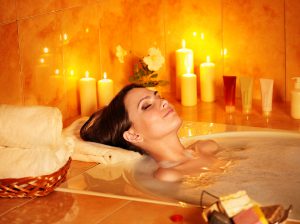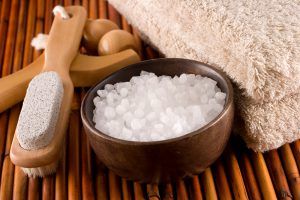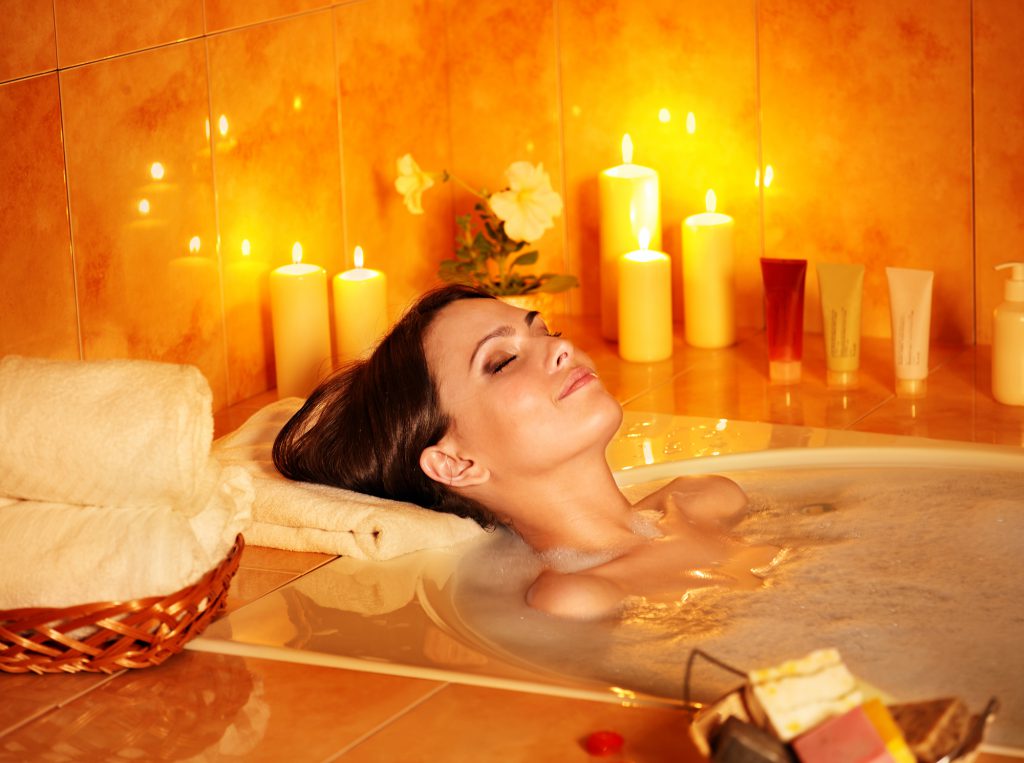In my quest to regain beautiful skin, I discovered that Dead Sea Salt and Epsom baths can improve the following conditions:
- Psoriasis
- Arthritis
- Dry Skin
- Eczema
- Stress
- Insomnia
- Muscular Aches and Pain
- Skin Allergies
The skin is strengthened and blood circulation improves. Toxins are also removed from the skin. Any chemical imbalances of the skin and body are improved and the skin’s natural PH levels are restored.

Studies show that Dead Sea Salt baths have shown positive results in symptom relief and lengthening remission of eczema and psoriasis sufferers.
Personally, when my skin was at its worst, I took a salt bath every evening, then tapered the frequency to every other day, then tapered off the baths, gradually. This means as my skin improved, I took them every other day, then every 2 days, then twice a week.
I chose not to rinse off afterwards as I felt that the salt was still working even after my bath. I would also add ground oatmeal and olive oil to the bath so that I was well moisturised. I found the baths to be very relaxing and I always had a good sleep afterwards. I would clean hairy parts daily with a kind soap like Turkish Olive oil soap or Black soap. And rinse off of course!
You will notice that having a 3-4 baths weekly for 3-4 weeks, will diminish the itch, scaling and joint complaints if you have any. Sleeping difficulties are also resolved. The spread of inflammation will decrease as well as the redness. However, as I was on medication for something else, my face took 4 months to heal from chronic scaling and sunburn in 2014.
It was the bowel cleansing and liver flushes carried out every 3 months that finally did the trick. My skin tone and texture returned to normal. I also drank plenty of water or cucumber juice to cool down the eczema body heat.

Only 1kg of salts per bath or more seems to be the most effective for treating skin conditions.
Here is my skin bathing method which is useful for preventing skin infection:
You will need olive oil, shea butter, 1kg packet of Dead Sea Salts and also 1 cup of ground oats.
The Method:
- Put some olive oil in your hand with shea butter and massage into your skin.
- Run your bath with lukewarm water.
- Add all the contents of the salts packet to the bath water.
- Add the oats.
- Put 1-2 tablespoons of olive oil in the water
- Soak in the bath for up to half an hour.
- Do not pat dry after your bath – allow your skin to air dry.
- Repeat Step 1.
The sea salts clean, disinfect and moisturise your skin too. Note that you should not use soap on eczematous skin as it will dry out your skin and leave it very itchy.
The oats has a quality about it that relieves your skin from itching. It also calms red, inflamed skin.
Shea butter prevents your skin from scarring as well as moisturises your skin. You will be able to find shea butter from either African shops or online.
If you have scratched your skin til it bleeds, you may need to massage your skin with aloe vera gelly that will heal your wounds and prevent from scarring. It also has the added quality of relieving the itch. Remember, aloe gelly first, then olive oil and shea butter.
If your clothes wick off the oil, you may need to ask your doctor to prescribe Tubifast bandages for your arms, torso and legs. It comes in different sizes, so you may need to check with the chemist to order the right size. These bandages are washable and can be used over and over.
Personally, I made a moisturising butter with melted coconut oil and shea butter instead of olive oil. You may have to do a small patch first to see whether you are allergic to coconut oil. My face was sensitive to coconut oil, but the rest of my body was fine.
If you have wet, oozing skin, dry your patches with Argiletz clay paste. Then apply aloe vera gelly to them. This can be applied as often as you need to during the day.
This may seem complicated to do, but it really is simple as long as you have these staple items in your kitchen at all times. Then whenever your skin flares, you have everything you need rather than panic.
Flotation Tank Experience
In 2013, a friend of mine suggested going to a nearby beauty salon that had a salt cave and a flotation tank. Since I didn’t know what a flotation tank was, I did an online search.
 Well basically, a flotation tank (or pod) has all the benefits of a regular salt bath except it is contains a very high concentration of Epsom salts. The temperature of the water is kept to the same as your body while you float in the water. Soft music is played and the lights are dimmed.
Well basically, a flotation tank (or pod) has all the benefits of a regular salt bath except it is contains a very high concentration of Epsom salts. The temperature of the water is kept to the same as your body while you float in the water. Soft music is played and the lights are dimmed.
Each session lasts for an hour or more if you feel brave enough, but what I found really interesting about the floating experience is that as I lay perfectly still in the water, my mind went into a dream-like state. This I found was very relaxing.
The only thing I didn’t like was that my eczema patches really stung. I stayed the 1-hour course though as the time seemed to whizz by. This time, I did rinse myself off and oiled up with olive oil after towelling. When I got home, I had a long nap. I felt that relaxed.
Having a salt bath, whether or at home or in a tank is a much safer alternative than bleach baths and they also remove bad bacteria from the skin.
There are several flotation tanks in beauty spas throughout the UK and numerous abroad, Sweden having the highest proportion of flotation tanks to people living there.
And The Price?
This flotation experience which lasts for an hour can set you back anything from £45-70 a session. You can have multiple sessions at a discounted rate if floating tickles your fancy. The price is high because each tank (or pod) costs between £15,000-40,000, and must be fitted with specially prepared rooms.
However, the experience is worth it and I noted that my skin healed at a faster rate within the following couple of weeks. That was impressive.
If you are interested in going to a floatation tank spa in London, there is one located at the London Flotation Centre, Isle of Dogs. The nearest station is South Quay DLR. The price? £45 an hour.
If you would like to know more about floating and the effects the salt can have on your skin, feel free to leave a comment or question below.


